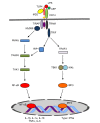Novel perspectives on non-canonical inflammasome activation
- PMID: 27471719
- PMCID: PMC4918253
- DOI: 10.2147/ITT.S57976
Novel perspectives on non-canonical inflammasome activation
Abstract
Inflammasomes are cytosolic multi-protein complexes that regulate the secretion of the proinflammatory cytokines, IL-1β and IL-18, and induce pyroptosis, an inflammatory form of cell death. The NLRP3 inflammasome is the most well-characterized member of this family and functions by sensing intracellular pathogen- and damage-associated molecular patterns and activating caspase-1, which processes the biologically inactive IL-1β and IL-18 precursors into active cytokines. Recent studies have identified an alternative mechanism of inflammasome activation, termed the non-canonical inflammasome, which is triggered by cytosolic sensing of lipopolysaccharide (LPS) derived from bacteria that have escaped phagolysosomes. This pathway is independent of Toll-like receptor 4 (TLR4), the well-known extracellular receptor for LPS, but instead depends on the inflammatory protease, caspase-11. Although our understanding of caspase-11 activation is still in its infancy, it appears to be an essential mediator of septic shock and attenuates intestinal inflammation. In this review, we bring together the latest data on the roles of caspase-11 and the mechanisms underlying caspase-11-mediated activation of the non-canonical inflammasome, and consider the implications of this pathway on TLR4-independent immune responses to LPS.
Keywords: IL-18; IL-1β; LPS; NLRP3; caspase-1; caspase-11.
Figures


References
-
- Janeway CA, Jr, Medzhitov R. Innate immune recognition. Annu Rev Immunol. 2002;20:197–216. - PubMed
-
- Medzhitov R, Preston-Hurlburt P, Janeway CA., Jr A human homologue of the Drosophila Toll protein signals activation of adaptive immunity. Nature. 1997;388(6640):394–397. - PubMed
-
- Poltorak A, He X, Smirnova I, et al. Defective LPS signaling in C3H/HeJ and C57BL/10ScCr mice: mutations in Tlr4 gene. Science. 1998;282(5396):2085–2088. - PubMed
-
- Hoshino K, Takeuchi O, Kawai T, et al. Cutting edge: Toll-like receptor 4 (TLR4)-deficient mice are hyporesponsive to lipopolysaccharide: evidence for TLR4 as the Lps gene product. J Immunol. 1999;162(7):3749–3752. - PubMed
Publication types
LinkOut - more resources
Full Text Sources
Miscellaneous

